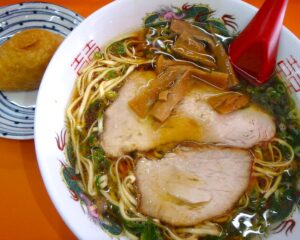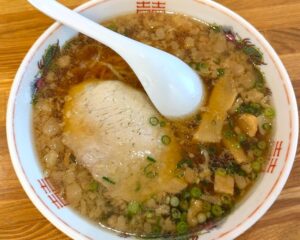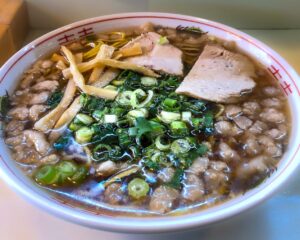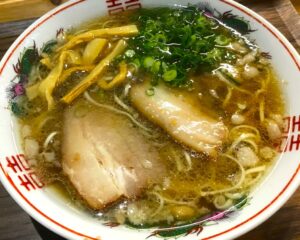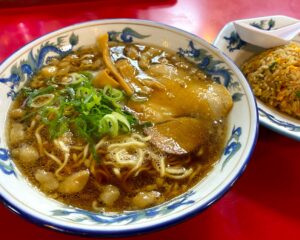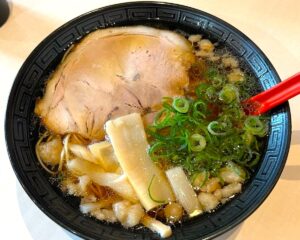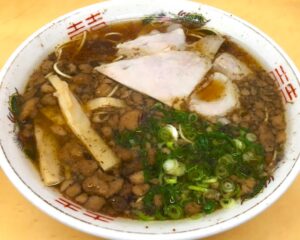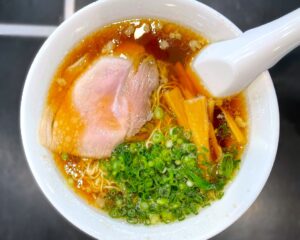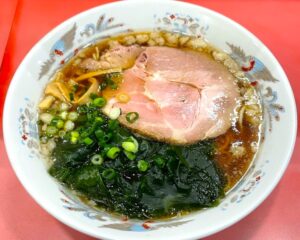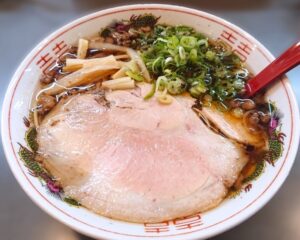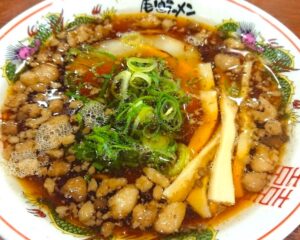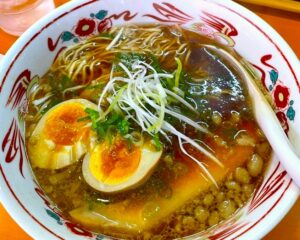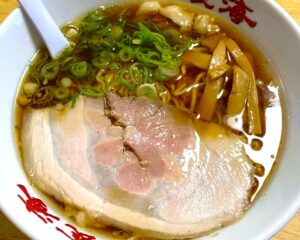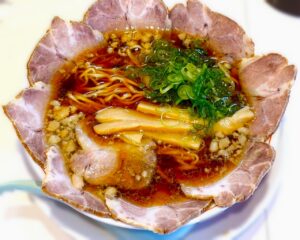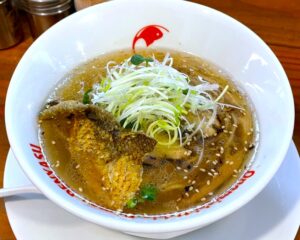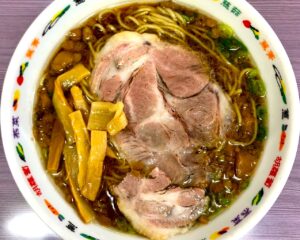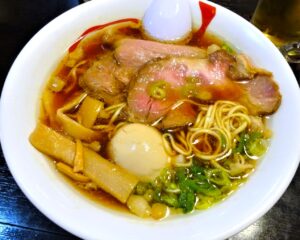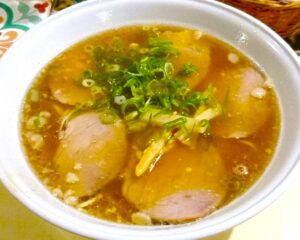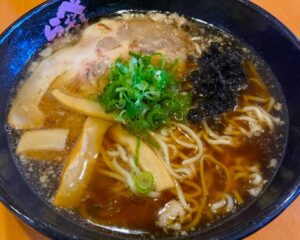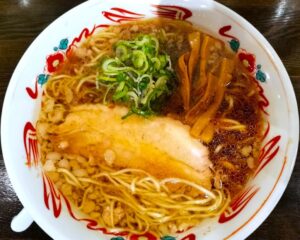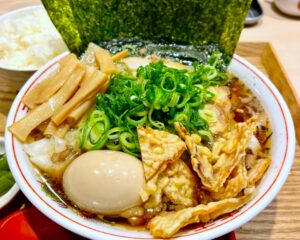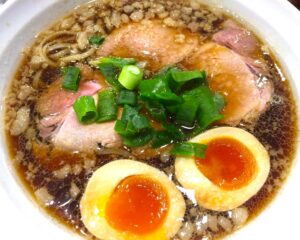Onomichi Ramen (Hiroshima Pref.)
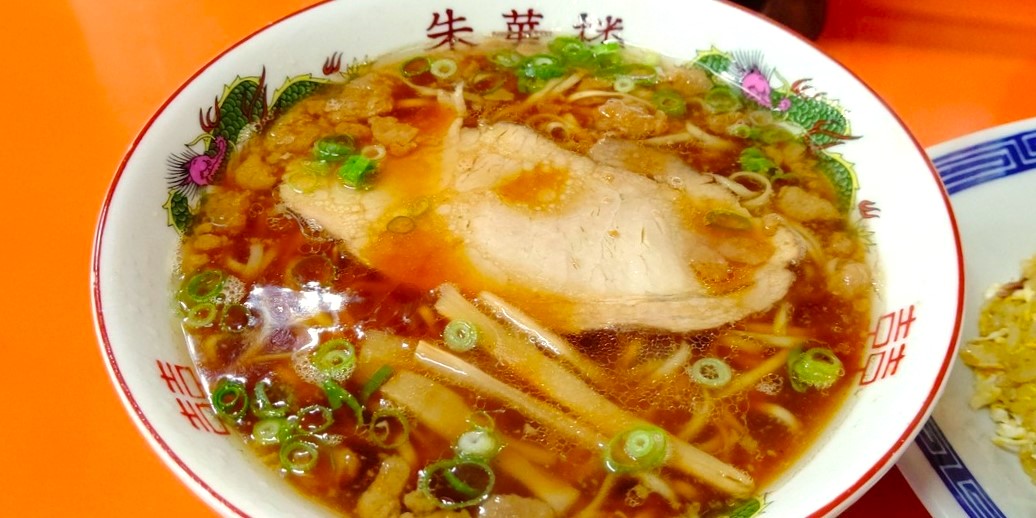
What is Onomichi Ramen(尾道ラーメン)?
Local ramen from the Bingo region of Hiroshima Prefecture, centered around Onomichi City.
The dashi is mainly chicken bones and small fish (such as sardines from Setouchi, fish meal), and the kaeshi is a dark brown soup with soy sauce as the main flavor. The noodles are medium-thin, straight, and have a chewy texture with little added water. Place the minced pork back fat on top of the soup. Unlike Tokyo’s backfat cha-cha type, it is served in a large-grained form (cut in a way that does not break the fibers).
Flat noodles, minced backfat, and small fish for dashi stock
Onomichi ramen was first started at a food stall around 1928 by Mr. Zhang(張さん) from Fujian Province. So it has a long history. However, the scale is not that large for the local area, and there are not many famous local stores. However, one of the things that made it famous not only in Tokyo but also throughout the country was the famous shop Shukaen (朱華園 founded in 1947 by 朱阿俊;Zhu Ajun as a food stall). This is a movement to bring local Onomichi ramen to the nation.
Onomichi ramen first attracted attention in 2005, when a 1/1 scale movie set of the battleship Yamato was built on the grounds of a shipyard in Mukojima (Onomichi City, Hiroshima Pref.) and opened to the public after filming. The number of tourists increased rapidly, and ramen shops were crowded until late at night to cater to the tourists.
Additionally, the Shimanami Kaido Cycling Road(しまなみ海道サイクリングロード), which connects Honshu(本州 main land) and Shikoku(四国) by crossing the islands of the Seto Inland Sea(瀬戸内海), was opened in 1999, and in 2014 was selected by CNN as one of the top 7 cycling routes in the world.
In addition, Onomichi is often the setting for movies, literature, and anime, and as tourism resources have grown, Onomichi, the starting and ending point, and its local food, Onomichi ramen, have also become popular. In addition, there is a large presence such as Inoue Seimenjo(井上製麺所), a long-established noodle factory founded in 1950 that responds kindly to sudden changes in orders.
There are three characteristics of Onomichi ramen.
●”Chewy flat noodles (rare in Western Japan)”
●”Minced back fat floating in the soup”
●”Using small fish from the Setouchi Inland Sea for dashi stock”.
However, Shukaen, Onomichi’s representative shop, has its roots in flat noodles and minced back fat, but does not use small fish, which is the third characteristic. Actually, this “small fish” was added by the person who wanted to sell Onomichi ramen to distinguish it from Setouchi. That’s why Shukaen is Onomichi ramen, but not Onomichi ramen. It seems that they will decline requests for interviews, etc. if there is a special feature on Onomichi ramen. The soup is based on chicken bones and only a small amount of pork bones are added.
“Shukaen”, which was affectionately known locally as Mr. Shu, closed in 2019, but “Shukarou(朱華楼)” has inherited its lineage, and the wife of the founder, Mr. Shu, had opened“Chuka Soba Shu(中華そば 朱)”in a 1-minute walk from Shukaen with their daughter.
Ramen-Japan / Examples of Ramen Shops
Examples of the long-established shops that serves Onomichi ramen
Let’s list some other popular shops. “Tsutafuji(つたふじ)” has a menu called “Chinese udon” that uses the same soup as Chinese soba(ramen). The soy sauce flavor goes well with udon. Chicken bones, pork bones, and small fish are used. “Ajihei(味平)” is something that my husband studied on his own and is unique for Onomichi ramen. In addition to chicken bones, pork bones, vegetables, dashi kelp, etc., they use dried scallops instead of small fish. The noodles are thin. The minced back fat is flavored. “Ajiryu( 味龍 )” sells non-chemical soup made with natural ingredients.
Furthermore, Fukuyama City(福山市), which is next to Onomichi City, is also a ramen town comparable to Onomichi, and there are many so-called Onomichi ramen shops, including branches of “Shukaen” and “Tsutafuji.”

